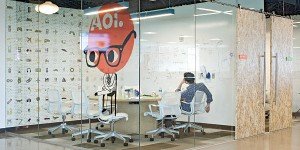
A conference room at AOL’s West Coast HQ Mathew Scott for Bloomberg Businessweek
By Douglas MacMillan
The company has opened its sleek new Palo Alto offices to Valley startups, hoping some of the creativity will rub off
“AOL is cool.” The phrase appears in big blue letters on a long whiteboard lining a hallway of AOL’s (AOL) newest outpost, in Palo Alto, Calif. Since the Internet giant signed a seven-year lease on a 225,000-square-foot building last August, it has thrown the space open to a wide assortment of startups, which work in close proximity to 170 of its own engineers. The new digs are part corporate office, part startup incubator, and part college community center. The hope for AOL executives is that some of that entrepreneurial energy rubs off on their 28-year-old company.
Nothing is less cool than professing one’s coolness, of course, especially if you’re an Internet dinosaur evoking a bygone era of dial-up modems. AOL was a hot stock in the 1990s, only to become half of AOL Time Warner in one of the worst mergers in U.S. history. The company spun off in 2009 and has a market cap of $2 billion; that’s a fraction of its value on the day the Time Warner merger was announced. Yet AOL’s quest for cred may actually be working. There’s a waiting list of startups that want to move in. “We really have tried to make our offices into centers of creativity where we can invite other people to come in and work with us,” says Tim Armstrong, chief executive officer of the New York-based company. “The opportunity is to take some of the world’s best entrepreneurs and technologists and have them work in a deeply engaging place.”
AOL’s building is less than a mile from Facebook and right around the corner from buzzy startups such as Cloudera and Box.net. More than 75 people from 25 companies—most with no formal AOL affiliation—work in the building. They range from a digital comic book maker, Graphic.ly, to a developer of anti-spam software called Impermium. Another tenant is SSE Labs, a business accelerator program that helps Stanford University students start companies. “Entrepreneurship is lonely and hard, so it’s really nice to have people who are going through the same hardships as you,” says Cameron Teitelman, a senior at Stanford who founded SSE Labs last summer.
The space is rent-free for now. Entrepreneurs will eventually pay AOL a discounted rent—and get free perks, such as access to a cafeteria with a pool table, foosball, and beer on tap, usually Samuel Adams or Anchor Steam. AOL hosts happy hours on Fridays and a biweekly lunch. A recent guest speaker: Arianna Huffington, who just sold her Huffington Post to AOL for $315 million.
The mix of occupants has already made life at AOL a little less stuffy. “We come in at 12 p.m. and stay until 6 a.m.,” says Teitelman of the SSE Labs students. The coming and going has attracted local attention. In January a Palo Alto policeman came by and asked AOL staffers why kids were arriving at and leaving the office at such odd hours.
There’s evidence that an exchange of ideas is starting to occur. The founders of MapMeIn, a startup trying to develop online floor plans of indoor spaces, have been trading technical pointers with Christian Dwyer, senior vice-president for AOL’s MapQuest site. During an informal chat recently, Stanford’s Teitelman explained to AOL’s head of West Coast recruiting that the company should give up on mass e-mail blasts to potential recruits and instead target students in a vaunted Stanford computer science class called CS210. Trent Herren, AOL’s head of initiatives, who’s leading the effort to attract startups, is delighted with the influx of talent. “These are the people that are convinced they are going to change the world,” he says.
AOL is well into an extensive remodeling of what it calls its West Coast HQ. During a recent visit, the offices smelled of fresh paint and workers wheeled furniture past an aquarium in the lobby. By May, the first floor will have a gym, a coffee shop, and a usability lab for observing product tests behind a one-way mirror. The new layout will roughly double the space available to startups, and AOL will begin reviewing applications for new occupants in April.
Other than a feeling of youthful vigor, what does AOL gain from all this? The company says it could get the inside track on investing in or acquiring one of these fledgling companies. AOL’s bigger idea, though, is that being surrounded by startups will help create an alluring culture at AOL, attracting good people who, in turn, create products. In 2009, Armstrong hired a former Yahoo! (YHOO) executive, Brad Garlinghouse, to help revive AOL. Garlinghouse gained notoriety five years ago for writing the so-called Peanut Butter Manifesto, which accused Yahoo of spreading its focus too thinly over too many products, like peanut butter on bread. As AOL’s president of applications and commerce—and the top executive in Palo Alto—he’s spearheaded projects such as Editions, an e-reading app for tablets, and the forthcoming revision of AOL Mail (code name: Project Phoenix).
While the mother ship has been shedding employees—AOL recently laid off more than 900—Garlinghouse is looking to fill 80 tech positions in Palo Alto, New York, and Virginia. “AOL wasn’t building great products, and the brand was reflecting that,” he says. “We have to expunge the ghosts of AOL and start fresh.”
The bottom line: AOL hopes its Palo Alto office will generate entrepreneurial energy, create better products, and give it an edge on acquisitions.
quoted from http://www.businessweek.com/magazine/content/11_14/b4222043205512.htm
